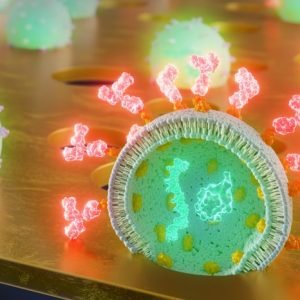
In the search for new materials to be used in space environments, researchers are focusing on the crystallization of substances. By accurately observing and understanding the crystallization process of a substance, they can adjust particle arrangements to enhance performance or control the formation process to create desired materials.
The Korea Research Institute of Standards and Science (KRISS) has become the first in the world to observe the structural evolution of solute molecules in extremely supersaturated aqueous solutions, revealing that changes in molecular symmetry impact on the formation of new metastable material phases. The research is published in the journal Nature Communications.
In the 1890s, the German chemist Wilhelm Ostwald recognized that supersaturated solutions often preferred to transform into a metastable intermediate phase rather than a thermodynamically stable one during crystallization, called Ostwald’s step rule. To date, various hypotheses have been proposed to explain the origin of this phenomenon, with the leading hypothesis being that changes in the molecular structure of solutes in the solution would be the main factor.
The experimental verification of the solutes molecular symmetry requires the in-situ measurement of the solution structure in a highly supersaturated solution. However, in a conventional experimental environment, it is very difficult to reach even twice its well-known solubility limit value.
The KRISS Space Metrology Group succeeded in achieving supersaturation levels exceeding four times the characteristic solubility limit value by levitating solution droplet using a self-developed electrostatic levitation device. They became the first in the world to observe the process where the molecular symmetry of solutes changes, altering the crystallization pathways and forming new material phases.
Senior research scientist Yong Chan Cho from the KRISS Space Metrology Group stated, “This achievement identifies the key factors in the formation of new material phases and suggests methodologies for forming the desired material phases. It can serve as a new milestone in the development of new materials for extreme environments such as space, and in new material research in the bio and medical fields.”
In addition, the research group succeeded in implementing ultra-high-temperature environments exceeding 4,000 K (3,726°C) using the electrostatic levitation device and precisely measuring the thermal properties of heat-resistant materials such as tungsten (W), rhenium (Re), osmium (Os), and tantalum (Ta).
These precise thermal property values for ultra-high-temperature heat-resistant materials, used in space launch vehicles, aircraft engines, and nuclear fusion reactors, are expected to enhance the safety and efficiency of their designs.
Principal research scientist Geun Woo Lee from the Space Metrology Group said, “Using the electrostatic levitation device, we can implement a microgravity environment similar to space to precisely measure the thermophysical properties of materials. Currently, advanced aerospace nations are conducting various experiments on the ground using this device to reduce costs and increase research efficiency.”
In the future, the research group plans to establish an integrated measurement platform to precisely measure the properties of materials in extreme environments such as ultra-high temperatures, supersaturation, and ultra-high pressures, based on the electrostatic levitation device.
More information:
Yong Chan Cho et al, Impact of molecular symmetry on crystallization pathways in highly supersaturated KH2PO4 solutions, Nature Communications (2024). DOI: 10.1038/s41467-024-47503-1
Citation:
Molecular symmetry can govern crystallization pathways in highly supersaturated solutions, researchers find (2024, October 31)
retrieved 31 October 2024
from https://phys.org/news/2024-10-molecular-symmetry-crystallization-pathways-highly.html
This document is subject to copyright. Apart from any fair dealing for the purpose of private study or research, no
part may be reproduced without the written permission. The content is provided for information purposes only.







